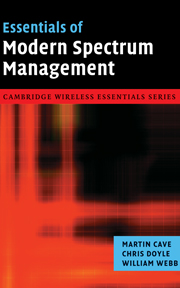Book contents
- Frontmatter
- Contents
- Acknowledgements
- I Emerging problems with the current spectrum management approach
- 1 Current spectrum management methods and their shortcomings
- 2 How changing technology is impacting spectrum management
- 3 Alternative ways of dividing spectrum
- II Markets
- III Regulation
- IV Conclusions
- Further reading
- Abbreviations
- Author biographies
- Subject index
- References
1 - Current spectrum management methods and their shortcomings
Published online by Cambridge University Press: 13 August 2009
- Frontmatter
- Contents
- Acknowledgements
- I Emerging problems with the current spectrum management approach
- 1 Current spectrum management methods and their shortcomings
- 2 How changing technology is impacting spectrum management
- 3 Alternative ways of dividing spectrum
- II Markets
- III Regulation
- IV Conclusions
- Further reading
- Abbreviations
- Author biographies
- Subject index
- References
Summary
Why spectrum needs to be managed
A large and growing part of the world's output relies upon use of spectrum. Frequencies are used both commercially, notably for mobile communications and broadcasting, and by public sector bodies to support national defence, aviation, the emergency services and so on. As demand grows spectrum needs to be managed to avoid the interference between different users becoming excessive. If users transmit at the same time, on the same frequency and sufficiently close to each other they will typically cause interference that might render both of their systems unusable. In some cases, “sufficiently close” might be tens or hundreds of miles apart. Even if users transmit on neighbouring frequencies, they can still interfere since with practical transmitters signals transmitted on one channel “leak” into adjacent channels, and with practical receivers signals in adjacent channels cannot be completely removed from the wanted signal. The key purpose of spectrum management is to maximise the value that society gains from the radio spectrum by allowing as many efficient users as possible while ensuring that the interference between different users remains manageable.
To fulfil this role, the spectrum manager provides each user with the right to transmit on a particular frequency over a particular area, typically in the form of a licence. Clearly, the spectrum manager must ensure that the licences that they distribute do not lead to excessive interference. In practice, this can be a highly challenging task.
- Type
- Chapter
- Information
- Essentials of Modern Spectrum Management , pp. 3 - 10Publisher: Cambridge University PressPrint publication year: 2007

